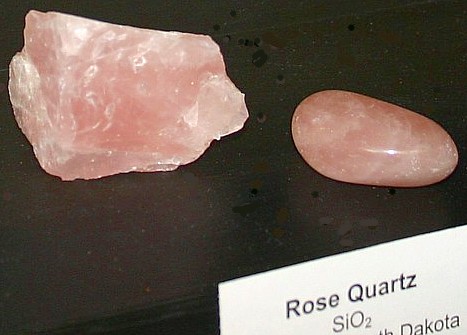
| QUARTZ MINERAL FACTS |  |
|
| The Gem and Mineral Collector's Photo Gallery by Nevada Outback |
|
. Quartz Mineral Facts:
Chemical Formula: SiO2
The Mineral is 46.7% Silicon by weight. Colors: Pure specimens are transparent or colorless, but most varieties are colored by the addition of pigments or impurities. When the coloring matter is opaque it may be present in sufficient quantity to render the mineral also opaque. Hardness: 7 Density: 2.65 Cleavage: None
Crystallography: Hexagonal Luster:. Its luster is vitreous, or sometimes greasy. Optics: (Refractive Index): a = 1.730; b = 1.758; y = 1.838 |
|
|
Composition,
Structure and Associated Minerals: Quartz resists most of the chemical agents except the alkalies. It dissolves in fused sodium carbonate and in solutions of the caustic alkalies. It is also soluble in HF and to a very slight degree in water, especially in water containing small quantities of certain salts. When heated to 575 the alpha variety passes into the Beta variety; at 870 both varieties pass into tridymite, and at 1470 the tridymite passes over into cristobalite. Gradual fusion occurs just below 1470. The varieties of quartz have received many different names depending largely upon their color and the uses to which they are put. They may be grouped for convenience into crystallized and crystalline varieties. The principal crystallized varieties are:Rock crystal, the colorless, transparent variety, that often forms distinct crystals. This is the variety that is used in optical instruments. Amethyst is the violet-colored transparent variety. Rose quartz is the rose-colored transparent variety. Citrine is a yellow variety. Smoky quartz is a smoky yellow or smoky brown variety that is often transparent or translucent, but sometimes almost opaque. The last four varieties are used as gems. Milky quartz is the white, translucent or opaque variety such as so commonly forms the gangue in mineral veins and the material of "quartz veins". Chalcedony is a very finely fibrous, transparent or translucent waxy looking quartz that forms mamillary or botryoidal masses. Its color is white, gray, blue or some other delicate shade. Carnelian is the name given to a clear red or brown chalcedony. Chrysoprase is an apple-green chalcedony. All of the colored chalcedonies are used as gems or as ornamental stones. Agate is a chalcedony, variegated in color. The commonest agates have the colors arranged in bands, but there are others, like "fortification agate" in which the colors are irregularly distributed, and still others in which the variation in color is due to visible inclusions, as in "moss-agates." |
|
|
|
Identification and Diagnostics Uses: Quartz is widely used in its various colored forms as gem and ornamental material, as amethyst, rose quartz, cairngorm, cat's-eye, tiger's eye, aventurine, carnelian, agate, onyx, etc. Used for abrading purposes either as quartz sand or as sandpaper. Used in the manufacture of porcelain, of glass, as a wood filler, in paints, scouring soaps, etc. As sand is used in mortars and cements. Large amounts of quartz sand are used as an acid flux in certain smelting operations. Its most extensive use, however, is in the manufacture of glass and pottery. Earthenware, porcelain and some other varieties of potter's ware are vitrified mixtures of clay and ground quartz, technically known as "flint." Ordinary glass is a silicate of calcium or lead and the alkalies, sodium or potash. It is made by melting together soda, potash, lime or lead oxide and ground quartz or quartz sand, and coloring with some metallic salt. A pure quartz glass is now being made for chemical uses by melting pure quartz sand.In the form of sandstone, it is used as a building stone, for paving purposes, etc. In the form of sand it is employed in various building operations. Bricks cut from dense quartzites (very hard and compact sandstones) are often employed for lining furnaces. The uses of honestones, oilstones, and whetstones are indicated by their names. |
|
|
|
Occurrence,
Localities and Origins: Rock crystal is found widely distributed, some of the more notable localities being: the Alps; Minas Geraes and Goyoz, Brazil; on the island of Madagascar; in Japan. The best quartz crystals from the United States are found at Hot Springs, Arkansas, and Little Falls, New York. Important occurrences of amethyst are located in the Ural Mountains and in Brazil. Found at Thunder Bay on the north shore of Lake Superior and in the United States in Oxford County, Maine; Delaware and Chester counties, Pennsylvania; Black Hills, South Dakota, etc. Smoky quartz is found in large and fine crystals in Canton Uri, Switzerland; at Pike's Peak, Colorado; Alexander County, North Carolina; at Auburn, Maine, etc. The chief source of agates at present is a district in southern Brazil and northern Uruguay. They are mostly cut at Oberstein, Germany, itself a famous agate locality. Agates are also found in Laramie County, Wyoming, and numerous other places in the United States. Massive quartz, occurring in quartz veins or with feldspar in pegmatite veins, is mined for its various commercial uses in Connecticut, New York, Maryland, Wisconsin, etc. Return to the Mineral Collectors Information Page |
|
|
|
|
 Rose quartz, South Dakota, USA |
|
|
Petrified (Fossilized) Wood, Jasper quartz, Arizona |
Amethyst-Citrine quartz, known as Ametrine |
|
|
|
|
|
.
Please note that the author, Chris Ralph, retains all copyrights to this entire document and it may not be reproduced, quoted or copied without permission.

NEVADA OUTBACK GEMS TURQUOISE AND JEWELRY